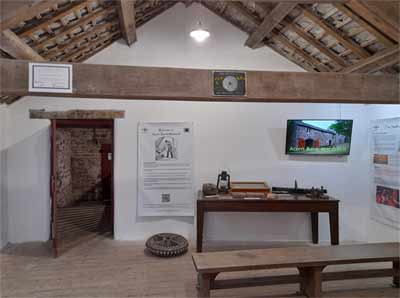Grain Store
When the mill was in operation, carts would have been pulled up to the back door of the grain store, which is on the upper floor level of the mill. Delivery to the first floor is common in upland regions as it reduces the number of times that the sacks of grain or flour have to be lifted up through the mill. In more level areas mills were often several stories high so the grain could be lifted to the top and then make its way down by gravity as it was processed.
The grain store is now also used as an information room for the mill with displays about the mill and milling.
Oats and Wheat
In northern England and Scotland oats and barley were the staple grains of the area. Indeed, in mediaeval times the bread eaten by common people might be made from rye, bere (a primitive form of barley) and/or peas. Most northern mills started life as oatmeal mills, though even oats only became a viable crop in northern parts in the 18th Century. While many mills, including Acorn Bank, introduced French Burr millstones for wheat milling, they still retain their character of oatmeal mills. Milling oats is rather more complex than wheat, involving drying, removing the husks by rough milling or shelling, and sieving. Finally, the cleaned oats, known as groats, can be milled in the same way as wheat.
In earlier days, only the rich could afford the luxury of bread made from white flour; the process of producing it involved milling wheat carefully so that the bran remained in pieces large enough to be sieved away from most of the white flour. It was therefore both time-consuming and wasteful, as some of the flour would always be removed with the bran. White bread was also thought to be healthier, as wholemeal bread produced wind!
As the fashion for white bread spread down the social ladder and outward from London, it was helped by improvements in milling equipment and technique and, particularly, millstones. Early mills might well have used local sandstone, later ones used millstone grit from various sites in northern England. However, such stones are both too abrasive and too prone to wear, resulting in the bran being too finely powdered to remove and the meal containing too much stone grit. Stones made from various volcanic materials were better, but most were dark coloured and so added a colour to the flour.
French Burr stones were the best answer; they wore slowly, leaving less debris in the meal and prolonging their working life between maintenance, or "dressing". They also produced a flour with the bran in discrete pieces suitable for sieving. It was very unusual for them to be made in one piece like those made from the other types of stone. Instead the stone was imported in pieces and cut and assembled in Britain, often at the ports. The pieces were cemented together and held with one or two iron hoops. Our runner stone, which is made from 17 pieces, carried a maker's name plate with the inscription "Cotton & Davies, 22 Cheapside, Liverpool" and we know that partnership was dissolved in early 1853.


